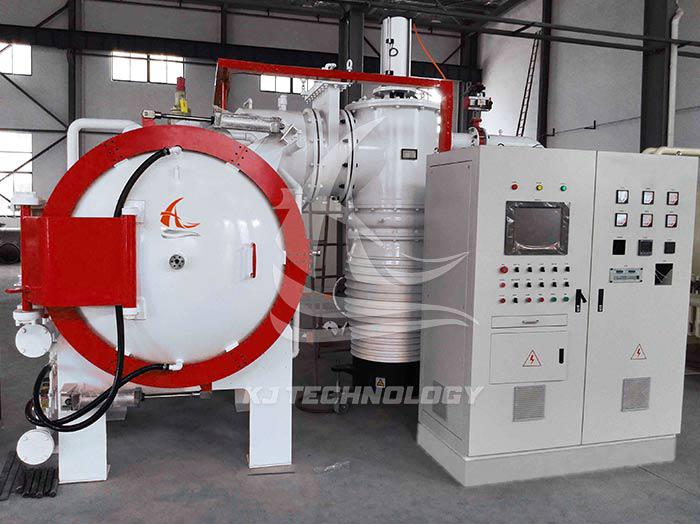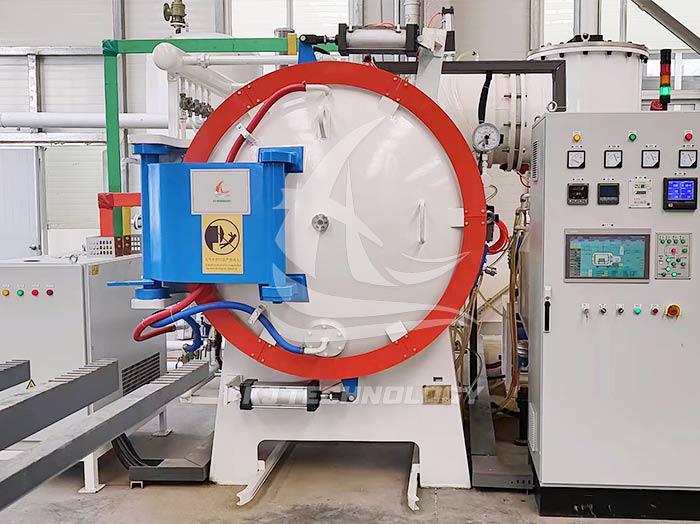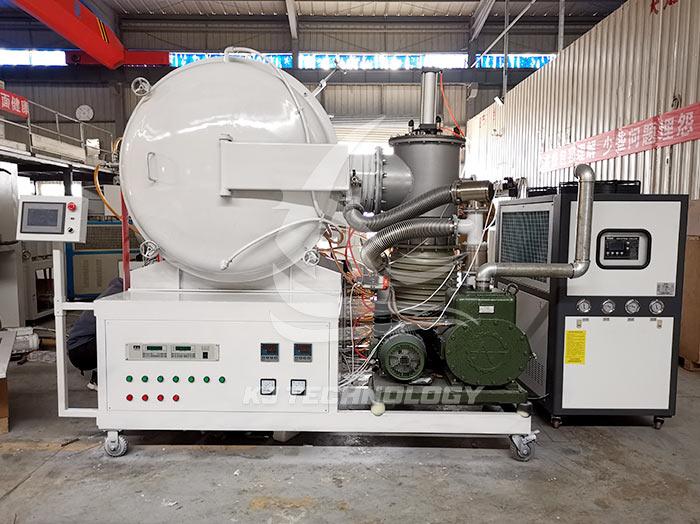What experiments can be conducted on a vacuum heat treatment furnace?
 05-19-2025 Author: KJ technology
05-19-2025 Author: KJ technology
Vacuum heat treatment furnaces can achieve various experimental purposes by heating and cooling materials in a vacuum or low-pressure environment, and are widely used in fields such as materials science, metallurgical engineering, aerospace, and new energy.
1. Research on Material Organization and Properties
Research on Phase Transition Behavior
Objective: To observe the phase transformation process of metal materials in a vacuum environment (such as austenitization and martensitic transformation), analyze the transformation temperature, kinetics, and microstructure evolution laws.
Case: Study the dissolution and precipitation behavior of carbides in high-speed steel (such as M2) during vacuum quenching, and optimize the quenching temperature and time.
Microstructure regulation
Objective: To regulate the grain size, phase composition, and distribution of materials by controlling heat treatment parameters (temperature, time, cooling rate).
Case: Vacuum solid solution+aging treatment is performed on titanium alloys (such as TC4) to obtain a fine and uniform α+β biphasic structure, which improves strength and toughness.
mechanical properties
Objective: To evaluate the mechanical properties such as hardness, strength, elongation, and impact toughness of materials after heat treatment.
Case: Compare the hardness (HRC) and wear resistance of mold steel (such as H13) after vacuum heat treatment and air heat treatment, and verify the superiority of vacuum treatment.
2. New material development and process optimization
Preparation of new alloys
Objective: To develop new materials such as high entropy alloys, amorphous alloys, shape memory alloys, and explore their vacuum heat treatment processes.
Case: Preparation of CoCrFeNiMn high entropy alloy, eliminating casting stress and improving plasticity through vacuum annealing.
Research on the Interface of Composite Materials
Objective: To analyze the interface reaction and bonding strength of metal matrix composites (such as carbon fiber reinforced aluminum matrix composites) during vacuum heat treatment.
Case study: Investigating the effect of vacuum heat treatment on the interfacial diffusion layer of SiC particle reinforced aluminum matrix composites and optimizing the interfacial bonding performance.
process parameters optimization
Objective: To determine the optimal heat treatment process parameters and maximize material properties through orthogonal experiments or response surface methodology.
Case: Vacuum solution treatment of 304 stainless steel, optimizing the effects of temperature (1000-1100 ℃) and time (1-3 hours) on intergranular corrosion sensitivity.
3. Surface modification and functionalization experiments
Vacuum carburizing/nitriding
Objective: To perform carburizing and nitriding treatment on metal surfaces in a vacuum environment to improve surface hardness and wear resistance.
Case: Vacuum low-pressure carburizing of gear steel (such as 20CrMnTi) to obtain a surface modified layer with high hardness (≥ 60HRC) and deep infiltration layer (≥ 0.8mm).
Vacuum brazing experiment
Objective: To achieve reliable connection between dissimilar metals or metals and ceramics under vacuum or protective atmosphere.
Case: Vacuum brazing of TiAl alloy and ceramic matrix composite material using Ag Cu Ti brazing material resulted in a joint strength of over 150MPa.
Preparation of surface coating
Objective: To prepare wear-resistant and corrosion-resistant coatings by combining vacuum heat treatment with physical vapor deposition (PVD) or chemical vapor deposition (CVD).
Case: Deposition of TiAlN coating on the surface of hard alloy cutting tools, combined with vacuum heat treatment to improve the adhesion between the coating and the substrate.
4. Failure Analysis and Defect Research
Heat treatment defect simulation
Objective: To simulate potential defects (such as cracks, deformations, and oxidation) that may occur in actual production by controlling heat treatment process parameters.
Case: Improper vacuum heat treatment of high-temperature alloys (such as IN718) and observation of abnormal growth of recrystallized grains leading to a decrease in room temperature plasticity.
residual stress analysis
Objective: To measure the residual stress distribution inside the material after heat treatment and evaluate its impact on material properties and service life.
Case: Using X-ray diffraction method to measure residual stress of 42CrMo steel shaft parts after vacuum quenching, optimizing cooling process to reduce stress concentration.
Reverse analysis of failed parts
Objective: To simulate vacuum heat treatment of failed parts and analyze the causes of failure (such as thermal fatigue and creep).
Case: Vacuum heat treatment experiments were conducted on fractured aircraft engine turbine blades, revealing creep embrittlement caused by the precipitation of grain boundary carbides.
5. Special environment simulation experiment
High temperature oxidation experiment
Objective: To study the high-temperature oxidation behavior of materials in vacuum or low oxygen partial pressure environments and evaluate their antioxidant properties.
Case: Compare the oxidation weight gain of nickel based alloys (such as GH4169) under vacuum and air environments at 900 ℃, and verify the antioxidant advantages of vacuum treatment.
Hydrogen embrittlement sensitivity test
Objective: To control hydrogen content through vacuum heat treatment and evaluate the brittleness tendency of materials in hydrogen containing environments.
Case: Vacuum dehydrogenation treatment was performed on high-strength steel (such as AISI 4340) to test its hydrogen embrittlement sensitivity and fracture toughness.
space environment simulation
Objective: To simulate a space vacuum and alternating high and low temperature environment, and test the thermal and dimensional stability of spacecraft materials.
Case: Conduct vacuum thermal cycling experiments on beryllium alloy reflectors for satellites to verify their deformation control ability within the temperature range of -180 ℃ to 150 ℃.
6. Teaching and Training Experiment
Demonstration of Heat Treatment Principles
Objective: To help students understand the basic principles of heat treatment through intuitive experimental phenomena such as color changes and phase transition organization.
Case: Demonstrate the microstructure transformation (ferrite+pearlite → uniform ferrite) during vacuum annealing of 45 steel, and compare the oxidation phenomenon during air annealing.
Experimental study on the influence of process parameters
Objective: To design comparative experiments and analyze the influence of different heat treatment parameters (such as temperature and time) on material properties.
Case: Vacuum quenching of T8 tool steel at different temperatures (760 ℃, 780 ℃, 800 ℃) was conducted to test the changes in hardness (HRC) and impact toughness (J/cm ²).
Innovative experimental design
Objective: To encourage students to independently design vacuum heat treatment experiments and cultivate scientific research thinking and practical abilities.
Case: A student designed an experiment on the effect of vacuum heat treatment on the fatigue performance of 3D printed titanium alloys and published an SCI paper.
7. Experimental equipment and technical support
Equipment selection suggestions
Laboratory grade vacuum furnace:
Temperature range: 1200-2200 ℃
Vacuum degree: ≤ 10 ⁻ ³ Pa
Temperature control accuracy: ± 3 ℃
Furnace cavity size: Φ 100-300mm (suitable for small batch experiments)
Industrial grade vacuum furnace (optional):
Processing capacity: 10-1000kg
Support atmosphere control (argon, nitrogen)
Suitable for pilot or large-scale experiments.
Supporting testing technology
Metallographic analysis: Observation of microstructure using optical microscope (OM) and scanning electron microscope (SEM).
Performance testing: hardness tester, tensile testing machine, impact testing machine to evaluate mechanical properties.
Composition analysis: Energy dispersive spectroscopy (EDS) and X-ray diffraction (XRD) were used to analyze the phase composition.
Summarize
The vacuum heat treatment furnace can conduct a full chain experiment from basic material research to high-end manufacturing process optimization through precise control of the heat treatment environment, and is an indispensable experimental platform in the field of materials science and engineering. Whether it is scientific research exploration, process development, or teaching and training, vacuum heat treatment furnaces can provide reliable technical support to help experimental personnel achieve breakthrough results.








